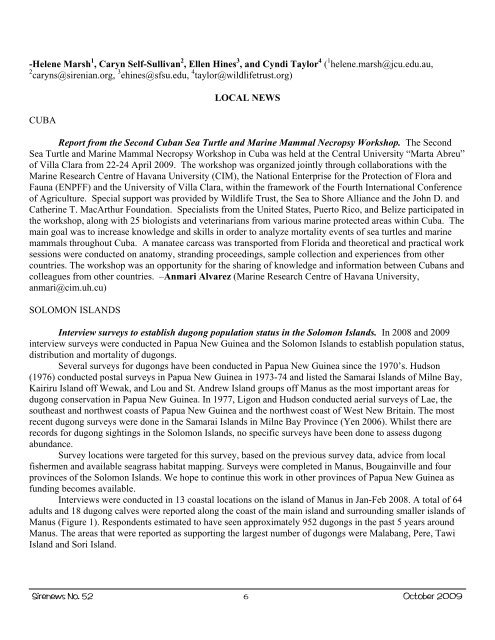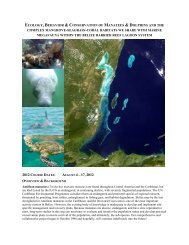Tribute to Dr. Akoi Kouadio - Sirenian International
Tribute to Dr. Akoi Kouadio - Sirenian International
Tribute to Dr. Akoi Kouadio - Sirenian International
You also want an ePaper? Increase the reach of your titles
YUMPU automatically turns print PDFs into web optimized ePapers that Google loves.
-Helene Marsh 1 , Caryn Self-Sullivan 2 , Ellen Hines 3 , and Cyndi Taylor 4 ( 1 helene.marsh@jcu.edu.au,<br />
2 caryns@sirenian.org, 3 ehines@sfsu.edu, 4 taylor@wildlifetrust.org)<br />
CUBA<br />
LOCAL NEWS<br />
Report from the Second Cuban Sea Turtle and Marine Mammal Necropsy Workshop. The Second<br />
Sea Turtle and Marine Mammal Necropsy Workshop in Cuba was held at the Central University “Marta Abreu”<br />
of Villa Clara from 22-24 April 2009. The workshop was organized jointly through collaborations with the<br />
Marine Research Centre of Havana University (CIM), the National Enterprise for the Protection of Flora and<br />
Fauna (ENPFF) and the University of Villa Clara, within the framework of the Fourth <strong>International</strong> Conference<br />
of Agriculture. Special support was provided by Wildlife Trust, the Sea <strong>to</strong> Shore Alliance and the John D. and<br />
Catherine T. MacArthur Foundation. Specialists from the United States, Puer<strong>to</strong> Rico, and Belize participated in<br />
the workshop, along with 25 biologists and veterinarians from various marine protected areas within Cuba. The<br />
main goal was <strong>to</strong> increase knowledge and skills in order <strong>to</strong> analyze mortality events of sea turtles and marine<br />
mammals throughout Cuba. A manatee carcass was transported from Florida and theoretical and practical work<br />
sessions were conducted on ana<strong>to</strong>my, stranding proceedings, sample collection and experiences from other<br />
countries. The workshop was an opportunity for the sharing of knowledge and information between Cubans and<br />
colleagues from other countries. –Anmari Alvarez (Marine Research Centre of Havana University,<br />
anmari@cim.uh.cu)<br />
SOLOMON ISLANDS<br />
Interview surveys <strong>to</strong> establish dugong population status in the Solomon Islands. In 2008 and 2009<br />
interview surveys were conducted in Papua New Guinea and the Solomon Islands <strong>to</strong> establish population status,<br />
distribution and mortality of dugongs.<br />
Several surveys for dugongs have been conducted in Papua New Guinea since the 1970’s. Hudson<br />
(1976) conducted postal surveys in Papua New Guinea in 1973-74 and listed the Samarai Islands of Milne Bay,<br />
Kairiru Island off Wewak, and Lou and St. Andrew Island groups off Manus as the most important areas for<br />
dugong conservation in Papua New Guinea. In 1977, Ligon and Hudson conducted aerial surveys of Lae, the<br />
southeast and northwest coasts of Papua New Guinea and the northwest coast of West New Britain. The most<br />
recent dugong surveys were done in the Samarai Islands in Milne Bay Province (Yen 2006). Whilst there are<br />
records for dugong sightings in the Solomon Islands, no specific surveys have been done <strong>to</strong> assess dugong<br />
abundance.<br />
Survey locations were targeted for this survey, based on the previous survey data, advice from local<br />
fishermen and available seagrass habitat mapping. Surveys were completed in Manus, Bougainville and four<br />
provinces of the Solomon Islands. We hope <strong>to</strong> continue this work in other provinces of Papua New Guinea as<br />
funding becomes available.<br />
Interviews were conducted in 13 coastal locations on the island of Manus in Jan-Feb 2008. A <strong>to</strong>tal of 64<br />
adults and 18 dugong calves were reported along the coast of the main island and surrounding smaller islands of<br />
Manus (Figure 1). Respondents estimated <strong>to</strong> have seen approximately 952 dugongs in the past 5 years around<br />
Manus. The areas that were reported as supporting the largest number of dugongs were Malabang, Pere, Tawi<br />
Island and Sori Island.<br />
Sirenews No. 52 6 Oc<strong>to</strong>ber 2009













